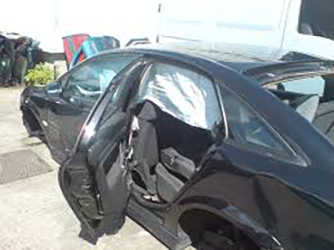
Among the most effective safety devices on passenger vehicles for nearly two decades have been side-curtain airbags (SCA), That’s especially true of those designed to be activated in a rollover accident. The first rollover-activated side curtain airbags (SCA) on the market became available on 2002.5 model year Ford Explorers and Mercury Mountaineer 4 door SUVs. They were first made available on models made after March 4, 2002.
SCAs are considered to be “passive supplemental restraint systems.” They were intended to add to the effectiveness of seatbelts, not replace them. Many studies of accident data have shown seatbelt use as very effective for preventing occupant ejection. They are also useful at reducing serious and fatal injuries in many accidents, including rollovers. One 1999 study found that 98.8% of belted rollover occupants were not seriously injured. The same study reported low serious injury rates of 1.4% to 3.1% for belted occupants in rollover crashes.
Research & Development of Side-Curtain Airbags was Rigorous
Prior to SCA implementation, the devices went through plenty of technical and rigorous development and testing. Researchers examined, developed, and tested every element of the safety devices. Those included the curtain airbag, the seatbelt pre-tensioners, the restraint-control module, and the platform-specific algorithms for sensing and deployment. The initial development of side-curtain airbags was intended to provide incremental head protection through cushioning. They were also equipped with a certain level of supplemental containment through reduced portal size. These objectives were balanced with the goal of minimizing the potential for injury caused by the rapid deployment and occupant interaction with the airbags. Ever since the introduction of side-curtain airbags, vehicle manufacturers have incorporated the devices into an ever-expanding portion of their vehicle fleets. There was also a healthy spike in market implementation beginning with the 2010 model year.
Over time, these systems have continued to evolve, especially in response to regulations. That said, however, SCAs have finite coverage, finite energy capacity, and finite head cushioning capacity. The National Highway Traffic Safety Administration (NHTSA) has maintained a system of guided impactor testing of production systems, as a way to demonstrate the abilities and the limitations of these devices, especially where the curtain is supported by vehicle structures.
Side-Curtain Airbags – Not Perfect, Just Safer
NHTSA testing demonstrates that an occupant can be ejected from a vehicle that slams full-force into an inflated SCA. Also, some studies of car accident data show that SCAs are effective at reducing injuries to vehicle occupants, but they cannot reduce occupant injury risk on their own. They seem to work best along with other safety devices. Studies of field accident data show that SCA-equipped vehicles reduce fatalities by between 20% and 40%. At the same time, other studies show that the average rollover crash in the field involves less than 2 quarter revolutions, and they estimate SCA efficacy to be better than vehicles without the devices. However, belted occupants in a vehicle with an SCA present also saw improvement. However, the presence of a deployed SCA cannot stop partial ejection or fatal injury in a rollover.
Besides the potential for prevention of ejection-related injuries, studies examining the effects on occupant movement and loading around SCAs have been performed. Researchers have tested catastrophic neck injuries, like “diving” injuries, in which rollover crashes result in body augmentation at vehicle-to-ground impact. Spin testing and full-scale rollover testing show that SCAs do not prevent the up-and-out motion of a belted passenger (or test dummy). They also do not prevent the head from coming into contact with or in close proximity to the inside roof. They don’t prevent “diving” injuries, especially when an occupant is ejected in a rollover crash. These studies have demonstrated the potential for occupants to sustain severe neck injury even if an SCA deploys. However, because side-curtain airbags are only intended to work with seatbelts, their effectiveness is without question.
Side Curtain Airbags Will Continue to Save Lives
On January 19, 2011, the NHTSA approved the Federal Motor Vehicle Safety Standard (FMVSS) No. 226, “Ejection Mitigation.” They established this standard “to reduce the partial and complete ejection of vehicle occupants through side windows in crashes, particularly rollover crashes.” According to the Final Rule, efforts to reduce ejections must also limit the number of times an occupant’s head hits the inside of the window. The NHTSA anticipated manufacturers would modify their existing side curtain airbags for increased window coverage, slow airbag inflation, and implement other changes designed to meet the standard. All vehicles were required to meet the new standards since September 1, 2017.
Since rollover-activated side curtain airbags became available, development and testing have been extensive and performed by everyone involved. As these devices have evolved, the design and performance goals have been balanced with the inherent risks of rollover accidents. The only way SCA systems will increase occupant safety is through constant change. Since the resulting system can’t stop all serious injuries, there must be constant evaluation of SCA technology. That means occupant injury outcomes must be seen in a specific rollover crash, depending on vehicle-, occupant-, and crash-specific factors. If you sustained airbag injuries in a San Antonio car accident, make sure you get the compensation you deserve. Contact Hill Law Firm Accident & Injury Lawyers today.
